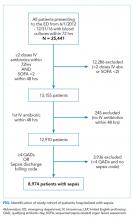The Association between Limited English Proficiency and Sepsis Mortality
BACKGROUND: Limited English proficiency (LEP) has been implicated in poor health outcomes. Sepsis is a frequently fatal syndrome that is commonly encountered in hospital medicine. The impact of LEP on sepsis mortality is not currently known.
OBJECTIVE: To determine the association between LEP and sepsis mortality. DESIGN: Retrospective cohort study.
SETTING: 800-bed, tertiary care, academic medical center.
PATIENTS: Electronic health record data were obtained for adults admitted to the hospital with sepsis between June 1, 2012 and December 31, 2016.
MEASUREMENTS: The primary predictor was LEP. Patients were defined as having LEP if their self-reported primary language was anything other than English and interpreter services were required during hospitalization. The primary outcome was inpatient mortality. Mortality was compared across races stratified by LEP using chi-squared tests of significance. Bivariable and multivariable logistic regressions were performed to investigate the association between mortality, race, and LEP, adjusting for baseline characteristics, comorbidities, and illness severity.
RESULTS: Among 8,974 patients with sepsis, we found that 1 in 5 had LEP, 62% of whom were Asian. LEP was highly associated with death across all races except those identifying as Black and Latino. LEP was associated with a 31% increased odds of mortality after adjusting for illness severity, comorbidities, and other baseline characteristics, including race (OR 1.31, 95% CI 1.06-1.63, P = .02).
CONCLUSIONS: In a single-center study of patients hospitalized with sepsis, LEP was associated with mortality across nearly all races. This is a novel finding that will require further exploration into the causal nature of this association.
© 2019 Society of Hospital Medicine
We defined sepsis based on Sepsis-3 consensus guidelines2 as a change in sequential [sepsis-related] organ failure assessment (SOFA) score ≥2 within the first 48 hours of ED presentation. The SOFA score is comprised of six variables representing different organ systems, each rated 0-4 based on the degree of dysfunction.2 Patient vital signs, laboratory data, vasopressor medication doses, and ventilator settings were used to determine the exact timestamp at which each patient attained a change in SOFA score ≥2. Missing values were considered to be normal. To adjust for baseline organ dysfunction, SOFA elements associated with elevated bilirubin and/or creatinine were excluded for patients with chronic liver/kidney disease based on Elixhauser comorbidities.27 We chose to focus on the first 48 hours in an attempt to capture patients with the most severe illnesses and the highest probability of true sepsis.
All primary and secondary International Classification of Diseases (ICD)-9/10 diagnosis codes were extracted from Clarity coding tables at the time of hospital discharge. Diagnosis codes signifying bacterial infection were grouped into the following categories based on type/location: pneumonia; bacteremia; urinary tract infection; and skin and soft tissue infection. All remaining diagnostic codes indicating bacterial infections at other sites were categorized as “Other”. If no codes indicating infection were present, patients were categorized as “None coded”. Patients with discharge diagnosis codes of “sepsis” were also identified. Dates and times of antibiotic administrations were obtained from the medications table. Time to first antibiotic was defined as the time in minutes from ED presentation to initiation of the first IV antibacterial medication. This variable was transformed using a natural log transformation based on best fit for normal distribution.
We limited our analyses to 8,974 patients who were diagnosed with sepsis as defined above and had either (1) ≥4 qualifying antibiotic days (QADs) or (2) an ICD-9/10 discharge diagnosis code of “sepsis” (Figure). QADs were defined based on the recent publication by Rhee et al. as having received four or more consecutive days of antibiotics, with the first dose given IV within 48 hours of presentation.28 Patients who died or were discharged to hospice prior to the 4th QAD were also included. These additional parameters were added to increase specificity of the study sample for patients with true sepsis. Patients admitted to all levels of care (acute care, transitional care unit [TCU], intensive care unit [ICU]) and under all hospital services were included. There were no missing data for mortality, race, or language. We chose to focus on patients with sepsis in this initial study as this is a common diagnosis in hospital medicine that is enriched for high mortality.
Primary Outcome
The primary outcome of the study was inpatient mortality, which was obtained from the hospital encounters table in Clarity.
Primary Predictors
The primary predictor of interest was LEP. The encounter numbers from the dataset were used to link to self-reported demographic data, including “preferred language” and need for interpreter services. A manual chart review of 60 patients speaking the top six languages was conducted to verify the accuracy of the data on language and interpreter use (KNK). Defining the gold standard for LEP as having any chart note indicating non-English language and/or that an interpreter was used, the “interpreter needed” variable in Epic was found to have a positive predictive value for LEP of 100%. Therefore, patients in the study cohort were defined as having LEP if they met both of the following criteria: (1) a self-reported “preferred language” other than English and (2) having the “interpreter needed” variable indicating “yes”.







